Tearing into a perfectly puffy poori served with aloo bhaji will win everyone's heart in your home. Puri is a popular breakfast in and around India made with wheat flour. It is commonly known as Indian fried bread which is slightly crispy on the outside and soft inside. Learn how to make the perfect puffed puri with step by step guide with pictures and video. Serve poori with Puri bhaji or poori masala, chana dal curry, coconut chutney or suji halwa for the popular halwa puri recipe.
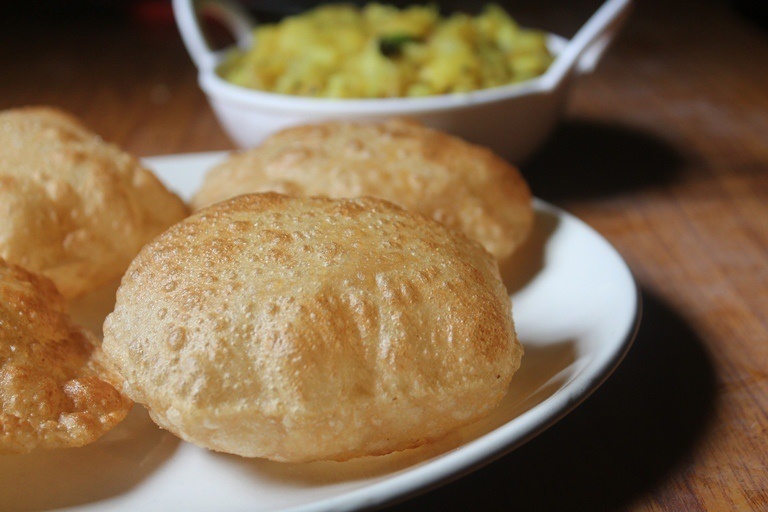
Poori Recipe
Puri Masala is one of my all time favourite dish. Every Indian house hold makes puri at least once a week. It is a popular South Indian dish and taste so yummy. I have shared 2 version of poori in this blog post. One recipe has some sooji added in it, which will make it puffy for long time. This is an everyday breakfast version, which is easy to make.
Jump to:
Along with bhatura, naan and tandoori roti, puri takes a place in every Indian household breakfast menu.
Table of Contents
About Puri Recipe (Poori Recipe)
Puri (sometimes spelled as poori) is a deep-fried bread made from unleavened whole-wheat flour that originated in the Indian subcontinent. It is eaten for breakfast or as a snack or light meal. It is usually served with a savory curry or bhaji, as in puri bhaji, but may also be eaten with sweet dishes.
Puris are most commonly served as breakfast and snacks. It is also served at special or ceremonial functions as part of ceremonial rituals along with other vegetarian food offered in prayer as prasadam.
Traditionally puri recipe uses wheat flour as its main ingredients. Sooji is added for making puri stay puffed longer. In hotels and restaurants they add all purpose flour (plain flour) to puri which makes a great difference in taste and texture.
Whole wheat flour poori has a nutty flavour, while poori made with all purpose flour taste more soft. Although it gets chewier as the poori cools. Popular Bengali version of puri known as Luchi is made exclusively from all purpose flour.
I serve poori with my everyday potato curry which is called as poori masala or kizhangu curry.
Watch Poori Recipe Video

More Breakfast Ideas,
Whole Wheat Bhatura
Bhatura
Luchi
Chole Masala
Easy Chana Masala
Aloo Peas Curry
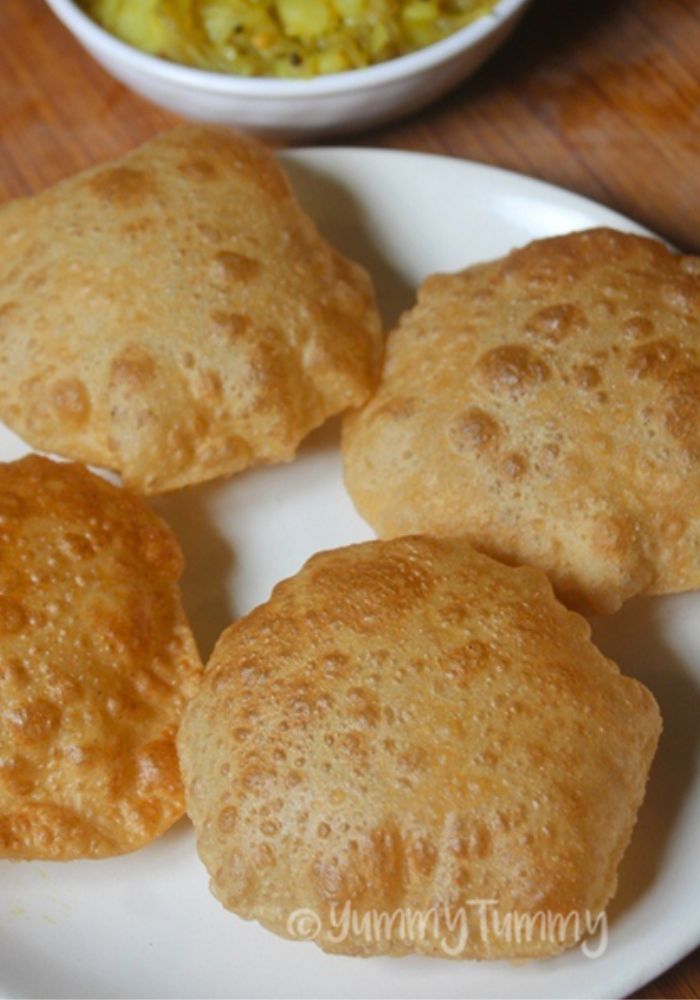
My Poori Recipe
Poori's are my absolute favorites. There are days when we make poori atleast once or twice a week. They are my favorite foods on the earth. Because I am on diet, because I have to reduce my waist line, because it is my wedding. I am forced to avoid this. I am missing my poori a lot. The speciality of poori is it should be puff till you eat this, that why it is called a puuuu----riiii.
But many of us find it really hard to get perfected in that. The poori's will nicely puff up when they are in oil, but once you remove them from the oil. They shrunk like a airless balloon. You don't need that right. So here I am giving you some tips to make the perfect poori, which stays puffed even when they are cold.
Poori Ingredients

Wheat Flour
Wheat flour gives a wonderful texture to your poori and makes it so delicious and soft. You can use wheat flour instead of plain flour but the texture will vary. In fact you can add half plain flour and half wheat flour for better texture.
Sooji
Sooji gives the texture to the poori dough made only with plain flour would be difficult to roll because of the texture. When adding little sooji to it. It will be easy to roll. I soak sooji in hot water for 5 minutes before adding into the dough. You can make poori without sooji, I have included a recipe for that too.
Oil
I add some oil into the flour and rub it like a shortcrust pastry which helps with the puffy texture of the poori. Use flavourless oil like refined oil, vegetable oil for frying.

Expert Tips
Making Dough
The key to make a perfect puffed poori is to add some sooji in the dough. But when you add the sooji directly in the flour, it stays grainy and make the poori hard. So soak it first and make it soft before you add it in the flour. Make poori dough stiffer and tighter than chapati dough.
Water quantity
I found that for every 1 cup of wheat flour you need little less than ½ cup of water. Water quantity depends on the type of flour you use. Add water slowly when making dough. If you find the dough to be sticky add more wheat flour and if you find the dough too dry add more water and knead.
Kneading
Kneading is essential to achieve soft puri. Mix and Knead the dough at least 5 minutes till the top of the dough is soft and uniform. Grease the dough slightly with oil so it doesn't dry out.
Resting the dough
Once you knead the dough, gluten formation happens in the dough. So allowing it to rest is important. Resting the dough covered in a warm spot, relaxes the gluten which makes rolling process easier.
Rolling the dough
Puri dough made with 1 cup of wheat flour will be enough to make at least 16 to 18 puris. Divide the dough into small equal size portions. Don't use dry flour to roll the dough. Instead for puri use oil. I like to grease my work surface, cutting board or silicon mat with oil and roll my puris in that. Roll out puri into even round disc. Don't roll it too thick or too thin.
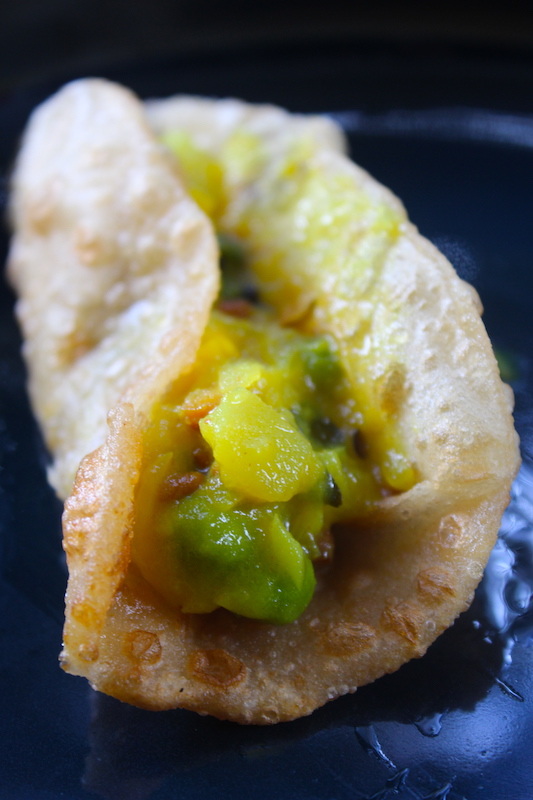
Testing Oil Temperature for frying puri
For perfect puffed puri, oil temperature is essential. To check whether oil is hot enough, drop a small portion of the dough in hot oil. If it rise immediately to the top then that oil is at the right temperature.
You can identify oil temperature when you fry your first puri. It is common that your first puri doesn't puff properly, you can adjust your oil temperature accordingly. Oil has to be super hot when you fry your puri.

How to Make Puffy Puri (Stepwise Pictures)
1)Take sooji in a bowl. Add hot water till it is immersed and let it soak for 5 minutes. This softens the sooji and makes it blend into the dough more easily.

2)Take wheat flour in a bowl.
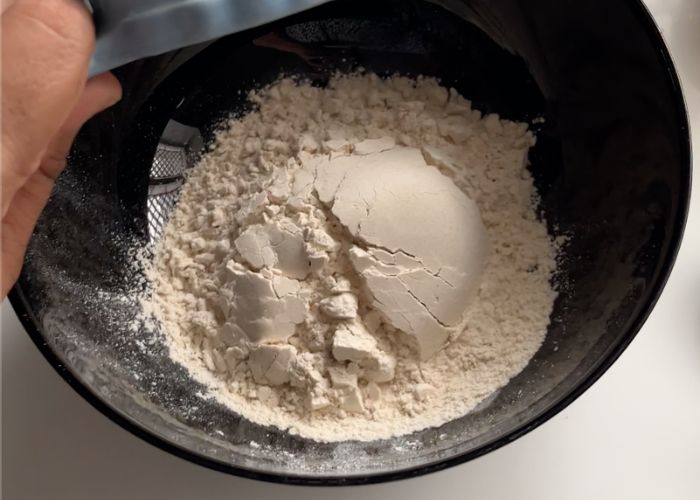
3)Add salt to taste.
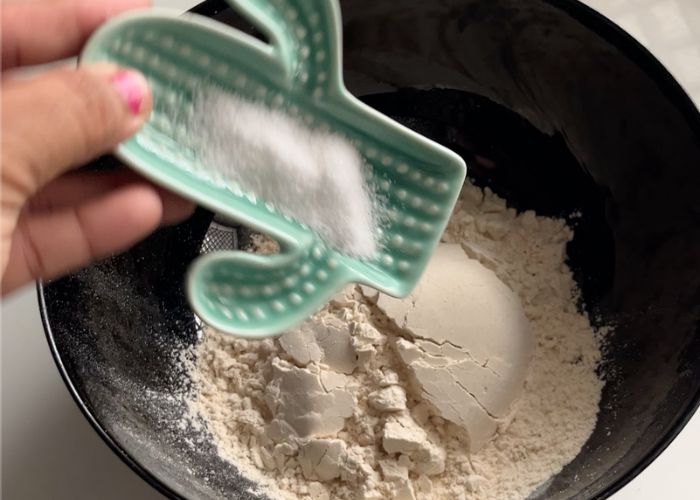
4)Add oil into the wheat flour and mix well.
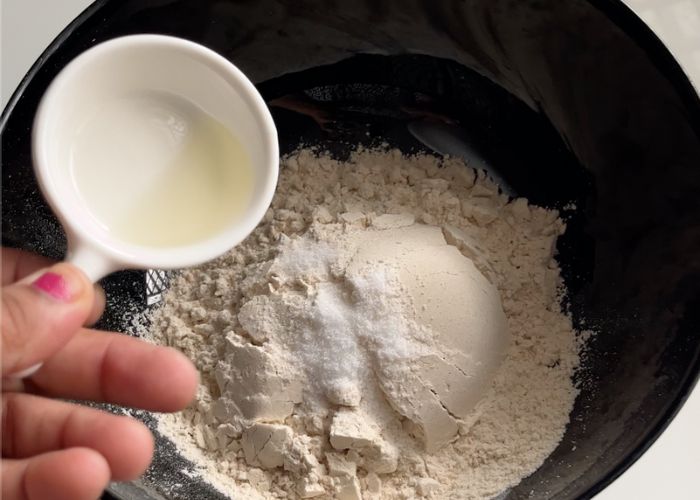
5)Add in the soaked sooji into the wheat flour. If there is too much water in the sooji, strain it and add.
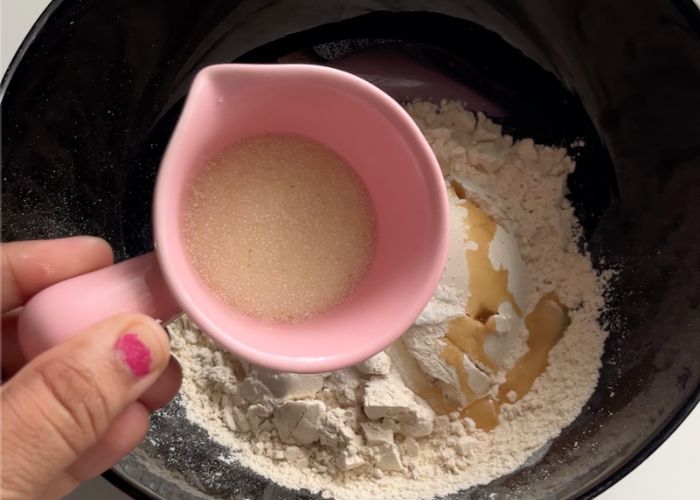
6)Mix the oil and sooji into the wheat flour using your fingers.
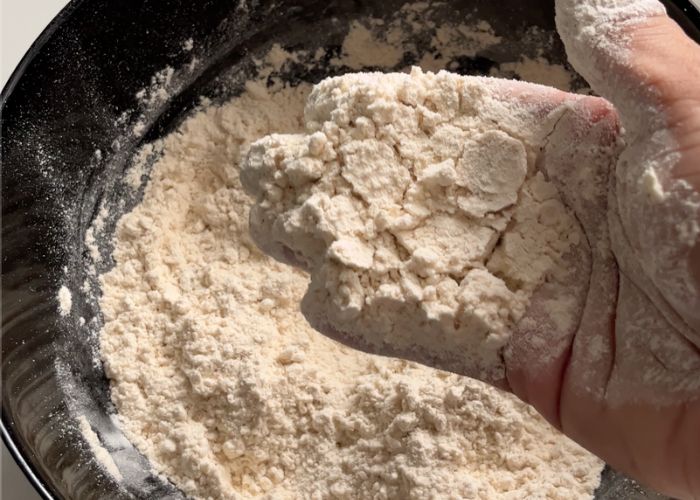
7)Add in water. Don't add too much water at once. Pour little at a time.
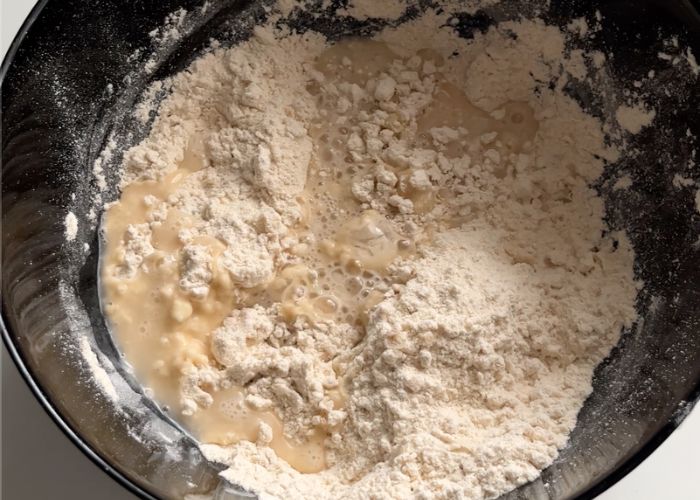
8)Make it into a stiff dough. Cover the dough with a wet cloth and let it rest for 30 minutes.

9)Divide the dough into equal portions. You can take the dough and roll it into a log like shape. Use a bench scraper or a butter knife to cut it into small even size portions.
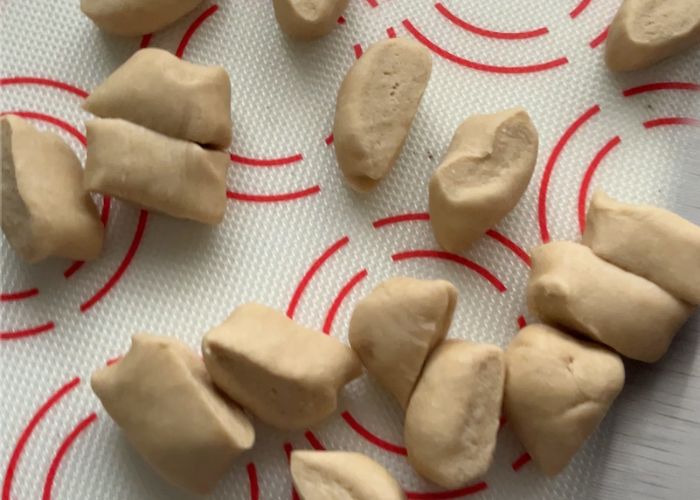
10)I use a silicon mat to roll the poori. You can grease your rolling sheet or table with some oil before rolling. Never use dry flour when rolling, the dry flour will burn when you fry the poori in hot oil which makes the oil dark and burnt.
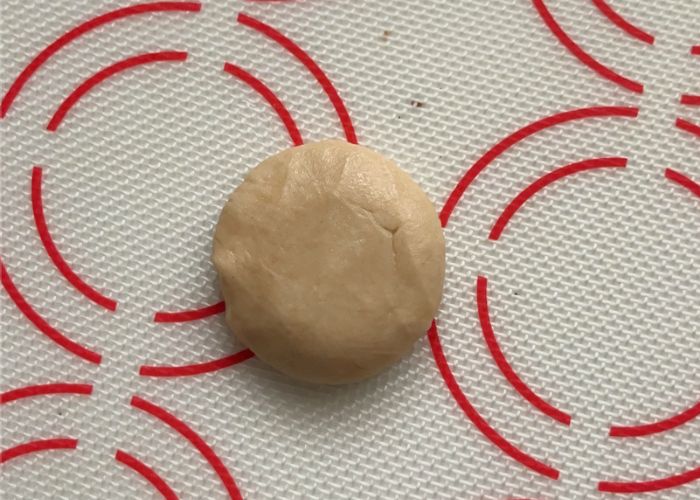
11)Roll the dough into circles.

12)Drop poori in hot oil gently.

13)Use a slotted spoon to press gently on top of the poori. This step makes the poori puff up like a balloon.
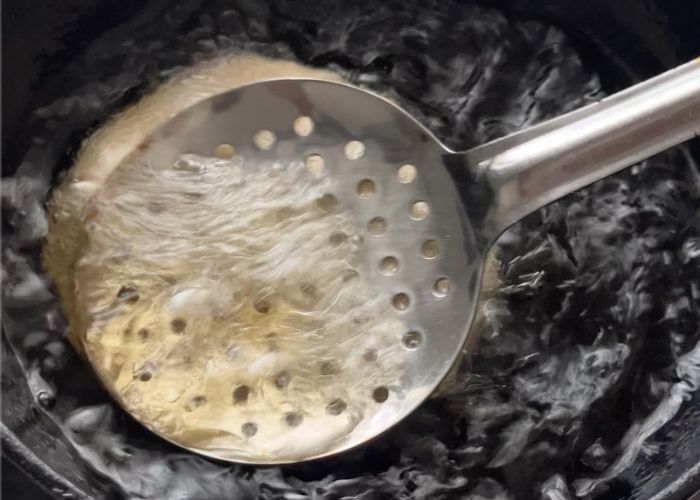
14)Like this. Once the poori is cooked for few seconds on one side, flip over.
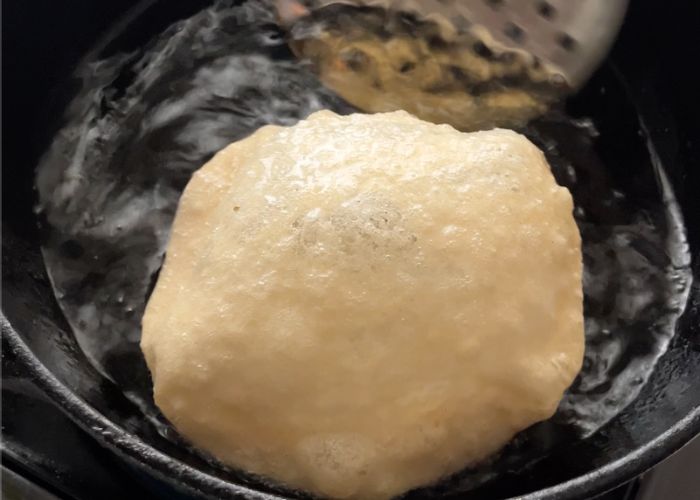
15)Flip over and cook on other side for few seconds.
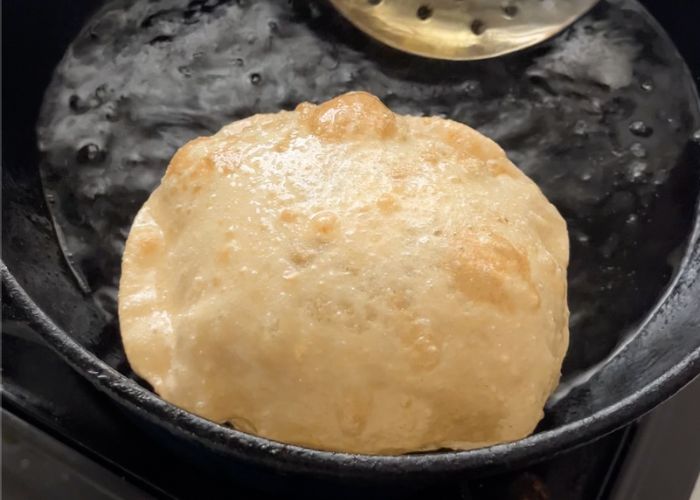
16)Gently remove the poori from oil using a slotted spoon.
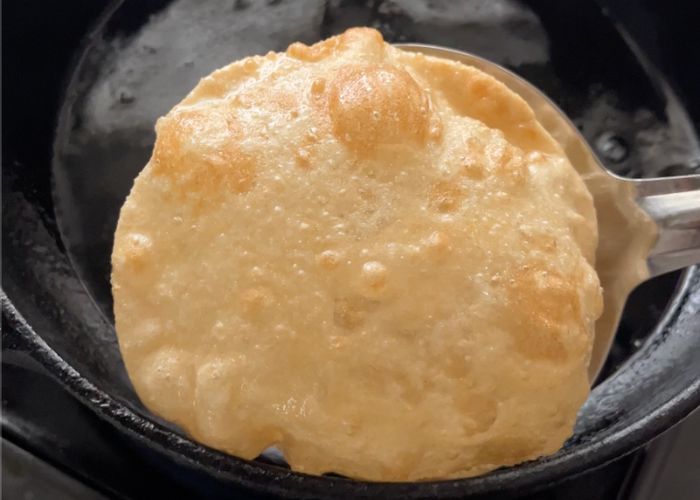
17)Serve poori with poori masala.
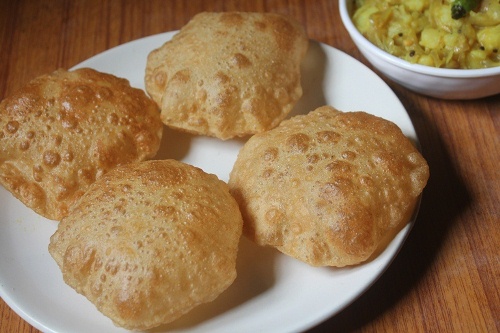
Another Way of Making Puri (without sooji)
This version of puri doesn't uses sooji. You can make perfect puri without the addition of sooji too. All you need is wheat flour, salt, oil and water to make the dough. You can add ½ cup all purpose flour to 1 cup of wheat flour to make the dough. But I used completely wheat flour.
Ingredients used
- 1 cup wheat flour
- ½ cup plain flour (optional)
- 1 tsp salt
- 1 tsp oil
- little less than ½ cup water
1)Take wheat flour in a bowl. You can use half wheat flour and half plain flour also.
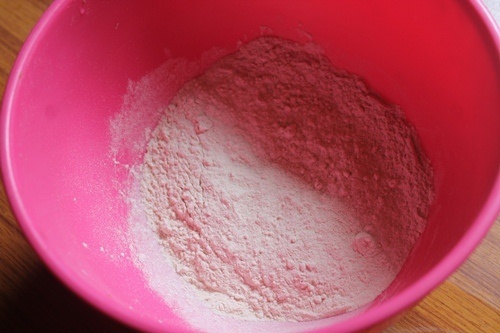
2)Add salt to taste
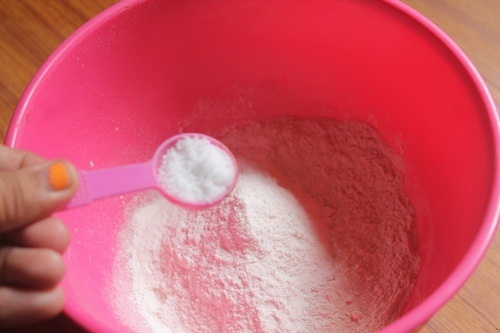
3)Add in oil and rub it into the flour.

4)Add in water little at a time and make a dough.
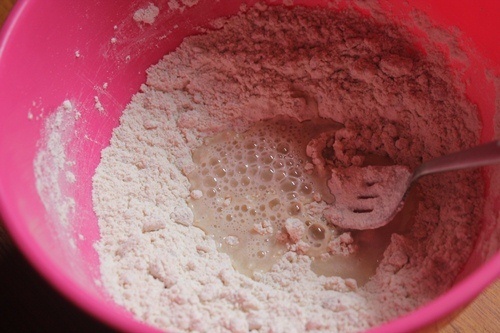
5)Let the dough rest for 30 minutes.

6)Divide the dough into equal portions.
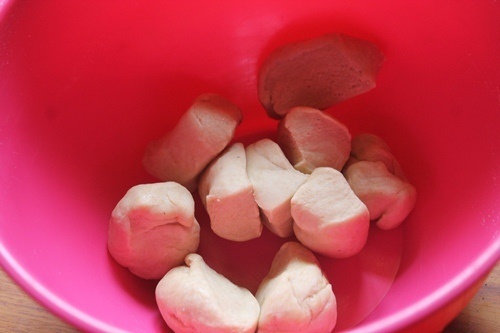
7)Take a small portion of dough on an well greased rolling board.

9)Use a rolling pin to roll the puri into small circle. Don't roll too thick or too thin.
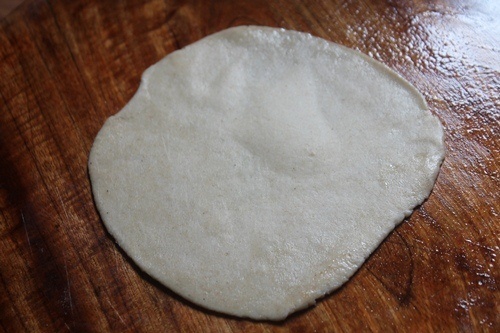
10)Make sure your oil is hot when you drop the poori in.
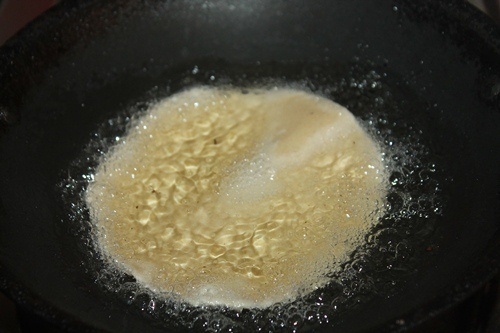
11)Use a slotted spoon to press on top of the puri gently so it puffs up.
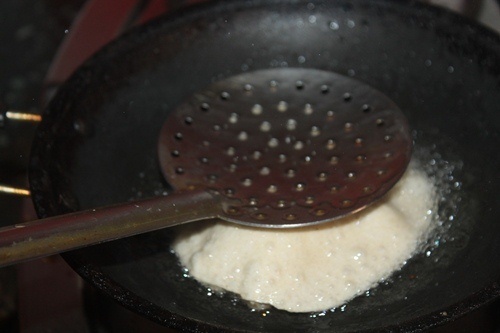
12)look how the poori has puffed up. it won't take long to cook the puri just few seconds on one side is enough.

13)Gently flip over and cook on other side for few seconds.

14)Strain the poori using slotted spoon and serve with aloo masala.
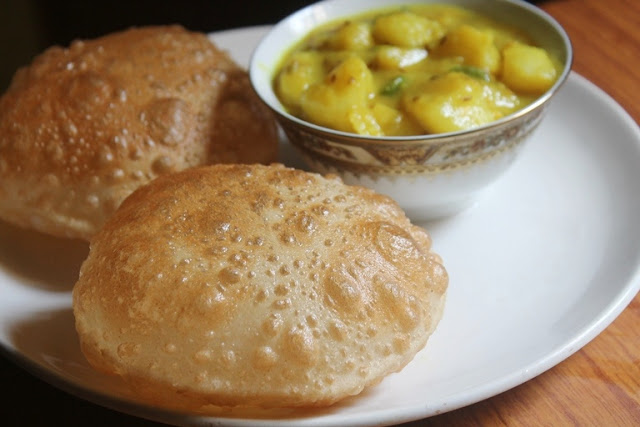
Variations
Palak Puri : I used blanched pureed spinach for making the dough instead of water. It makes the dough green colour and added nutrients. Great for kids.
Methi Puri: dried fenugreek leaves or fresh methi is finely chopped and add into the dough. Methi puri has a wonderful aroma which can be had with a cup of tea.
Stuffed Puri: Thick spiced mashed potatoes is stuffed inside two rolled out puri dough which is then fried. You don't need any side dish with this stuffed puri. Great to put in kids lunch box.
Masala Puri : Add 1 tsp each roasted cumin powder, chilli powder, ajwain, dried fenugreek leaves to puri dough.
Frequently Asked Questions (FAQ)
Why my poori don't puff?
For perfect puffed puri, oil temperature is essential. If your puri is not puffed, heat the oil more. Also once you drop the rolled puri in hot oil, make sure you use a slotted spoon to press the top for encouraging the puri to puff up.
Why my puffed puris collapse after frying?
Adding 1 tsp of sooji will ensure that your puri doesn't collapse once you fry them. Also give few extra seconds in hot oil when frying puri to make it slightly crispy which prevents the puri from collapsing.
Why is my puri chewy & hard?
Using too much all purpose flour will make puri chewy. If the dough is hard and dry it will result in hard puri.
Why is my puri oily?
Oil temperature is not hot enough which made puri drink lots of oil. Heat oil till super hot when frying. Also sticky puri dough will make puri oily, add more wheat flour and knead well.
What is the difference between puri and poori?
Puri also known as Poori in some parts of India. Both are same with different pronounciation. Puri (sometimes spelled as poori) is a deep-fried bread made from unleavened whole-wheat flour that originated in the Indian subcontinent.
What are the ingredients of poori?
Traditionally puri recipe uses wheat flour as its main ingredients. Sooji is added for making puri stay puffed longer. In hotels and restaurants they add all purpose flour (plain flour) to puri which makes a great difference in taste and texture.
Which oil is best for frying puri?
Any flavourless neutral oil like refined oil, sunflower oil, canola oil is great for frying poori | puri.
Is poori bad for health?
Poori is deep fried Indian bread. It is advisable to consume it in moderation because of their high oil content.
How many calories are there in 2 puri?
One puri contains roughly 110 calories. So a puri set comes to 220 calories. Along with the side of bhaji the calorie count may vary.
Serving Suggestions
Traditionally poori is served with my aloo curry which is called as poori masala or kizhangu curry. You can serve poori with wide variety of side dishes.
Capsicum Kurma: If you are bored of potato bhaji side dish, you can make this capsicum kurma for a change.
Chana Masala : Another classic combo for puri.
Dum Aloo - little time consuming but so worth it.
Punjabi Aloo Curry - Tangy potato curry with tomatoes goes well with puri.
No Potato Poori Masala - If you run out of potatoes, then this recipe will be a saviour.
Aloo Kurma - hotel style kurma with coconut and cashew paste added.
Coconut Chutney - simple and quick side dish which is loved in our family.
📖 Recipe Card
Poori Recipe | Puri Recipe | How to Make Puffy Soft Puri
Ingredients
Poori Recipe (with Sooji)
- 1 cups Wheat Flour
- 1 tsp Sooji | Rava | Semolina
- Salt
- 1 tbsp Hot water
- 1 tsp Oil (more for deep frying)
- ⅓ cup Water (as needed)
Poori Recipe (without Sooji)
- 1 cup Wheat Flour
- ½ cup Plain Flour (All Purpose flour) (optional)
- Salt to taste
- 2 tsp Oil (more for deep frying)
- ½ cup Water (as needed)
Instructions
Poori Recipe (with sooji)
- Take sooji in a small bowl. Add in 1 tbsp of hot water and mix well. Leave it to soak for 5 minutes. once soaked if there is too much water left in the sooji you can drain some off. Else you can use soaked sooji as it is.
- Now let's make the dough. Take wheat flour, salt, soaked sooji in a bowl. Add in oil and rub it into the flour. Add water slowly and knead to a stiff dough. Rest the dough for 15 to 30 minutes.
- Divide the dough into equal portions. Take a dough ball, roll it in an oiled surface into rounds. don't roll too thin or too thick.
- Drop poori in oil, press on top using a slotted spoon till puffy, flip over and cook for few seconds. Strain the poori using a slotted spoon and Serve with poori masala.
Poori Recipe (without sooji)
- Now take wheat flour, plain flour (if using) salt, oil in a bowl and mix with your hands so that everything is evenly mixed.
- Slowly add in water and mix well and make into a dough. Knead the dough for 5 mins so that it gets smooth and even. Apply some drops of oil on the top and cover it with a bowl. Let it rest for 30 mins.
- Divide the dough into equal portions. Take a dough ball, roll it in an oiled surface into rounds. don't roll too thin or too thick.
- Now time to fry. Heat oil for deep frying. When it is hot drop the poori in and press the top so that it puffs up.
- Cook on both sides till they turn golden. Drain and serve with korma or potato masala.
Video

Notes
- Soaking sooji in hot water for 5 minutes will soften the sooji a little which makes it blend into the dough a lot better.
- Mix oil and sooji into the wheat flour before adding water.
- Add water slowly making the dough else it may get sticky.
- Knead the dough for at least 5 minutes.
- Make sure the oil is super hot when frying the poori so it puffs up.
Nutrition
If you have any questions not covered in this post and if you need help, leave me a comment or mail me @[email protected] and I’ll help as soon as I can.
Follow me on Instagram, Facebook,Pinterest ,Youtube and Twitter for more Yummy Tummy inspiration.


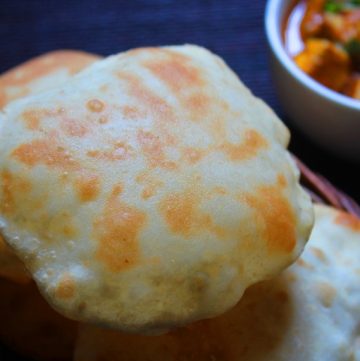
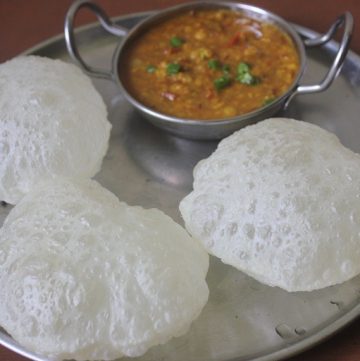

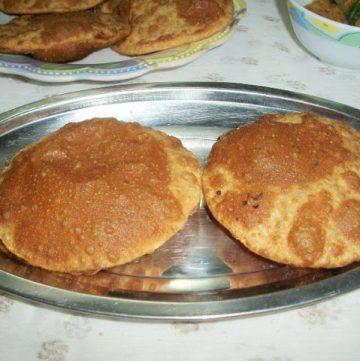






Leave a Reply